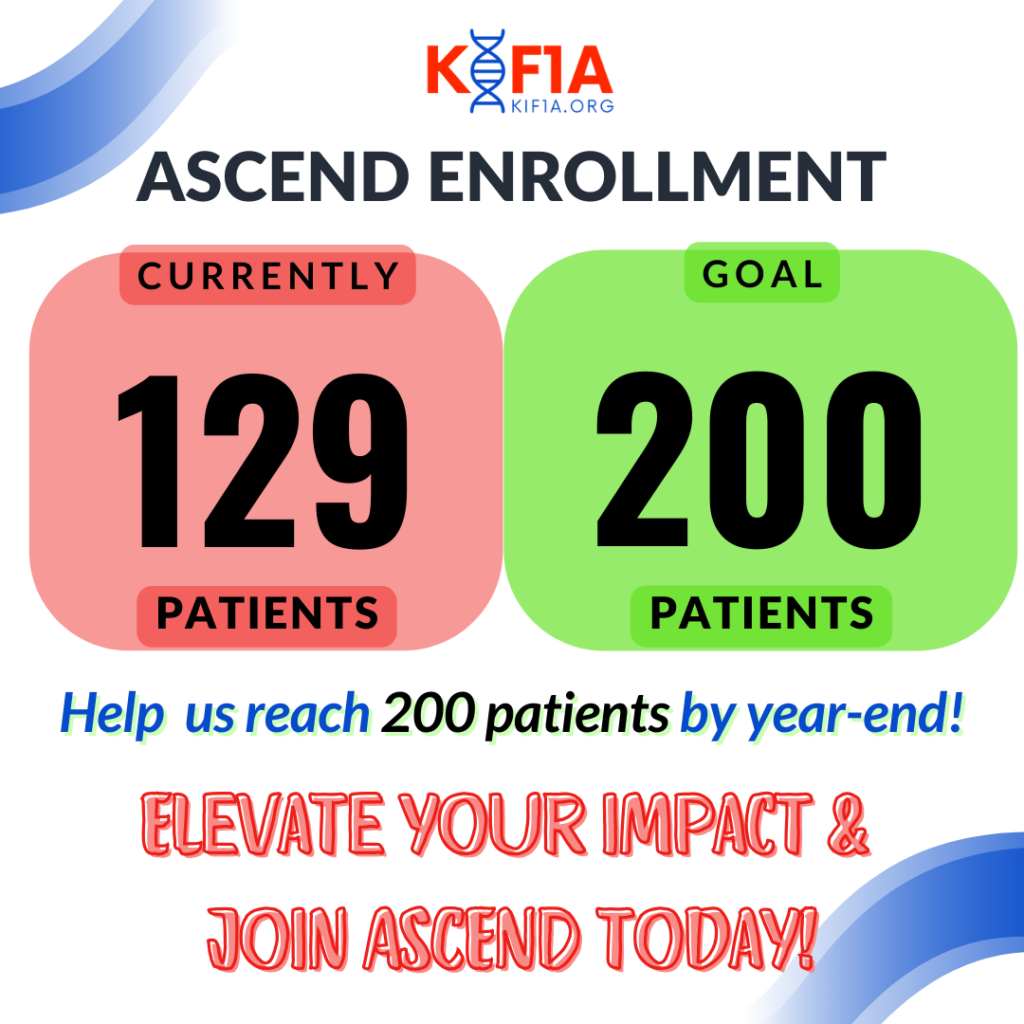Dear KAND Community!
We are thrilled to announce the recent publication of two KAND Natural History Study articles! We invite everyone to read the articles and learn about the latest data on KAND symptoms.
We sincerely thank all the participants and researchers whose contributions have been crucial in reaching these advancements in KAND knowledge and understanding.
With hope,
Angie Fuller, Director, Angie@kif1a.org
KAND Natural History Study Articles:
Heterogeneity of comprehensive clinical phenotype and longitudinal adaptive function and correlation with computational predictions of severity of missense genotypes in KIF1A-associated neurological disorder.
Khemika K. Sudnawa, Wenxing Li, Sean Calamia, Cara H. Kanner, Jennifer M. Bain, Aliaa H. Abdelhakim, Alexa Geltzeiler, Caroline M. Mebane, Frank A. Provenzano, Tristan T. Sands, Robert J. Fee, Jacqueline Montes, Yufeng Shen, Wendy K. Chung
https://doi.org/10.1016/j.gim.2024.101169
Please email impact@kif1a.org to request the full article)
To break down the title, this study investigated how KAND symptoms vary across patients, how those symptoms progress over time, and probed the relationship between protein mutations and symptom severity.
Key Takeaways:
- Movement: 30% of patients walk independently and 25% walk with an assistive device. Common features include reduced muscle tone in the core and arms, difficulty with coordination, and spasticity in the legs accompanied by atrophy.
- Cognitive: KAND patients had reduced scores on the Vineland Adaptive Behavior Scale, with spatial reasoning the most impacted in correlation with motor symptoms. Socialization scores were higher than daily living skills. Vision loss and lack of mobility were associated with worse cognitive outcomes, representing crucial clinical targets.
- Epilepsy: 41% of families report seizures, and seizures were associated with worse outcomes on cognitive tests. “The caregiver report of epilepsy is reliable and was verified by medical record review and/or review of clinical EEGs. These results confirm that KIF1A should be considered an epilepsy gene and that baseline EEG is warranted in newly diagnosed patients.“
- Vision: 84% of patients had some level of visual impairment; specific symptoms, including optic nerve atrophy, depth perception impairments, and color vision deficits, occurred at much higher rates than previously estimated. “Since individuals with KAND may be cognitively impaired, it may be difficult for them to describe their visual symptoms, especially if they have never had normal vision. We recommend regular assessments with a neuro-ophthalmologist to assess for optic nerve atrophy and cataracts that we have observed in some older individuals.“
- Brain imaging: Cerebellar atrophy was common; corpus callosum thinning and cortical loss were observed in some cases as well.
Thank you!
This is the first Natural History Study publication since 2021, and the largest cross-sectional study of KAND patients ever: 177 completed the initial ASCEND online study and 129 are still in contact for annual follow-ups; 57 of those families also participated in the in-person KOALA study, helping us establish clinical metrics so we know how to test potential therapeutics.
We’re grateful to every family who participated so we can better identify and advance treatments for KAND. And a huge thank you to the teams at Columbia University and Boston Children’s Hospital.
Ophthalmic findings in the KIF1A-associated neurological disorder (KAND).
Abdelhakim AH, Brodie SE, Chung WK
https://doi.org/10.1016/j.ajo.2024.06.025
Please email impact@kif1a.org for the full article.
Key Takeaways
- Average visual acuity was 20/43 in pediatric patients, and 20/119 in adults, indicating potential progression. Optic nerve atrophy was observed in 95% of patients assessed. “Visual evoked potentials showed findings consistent with optic neuropathy and visual dysfunction even in the absence of obvious structural changes on OCT.“
- More subtle visual deficits were commonly observed, including depth perception, peripheral vision, and color vision.
- Strabismus, improper muscle coordination of the eyes, was common, with cases of exotropia, esotropia, and 4th nerve palsy observed.
- Vision problems in KAND may require more comprehensive assessments: “Families should be counseled regarding visual impairment in KAND patients, so as to obtain appropriate support and assistance to maximize safety, functionality, and learning.“
📢Call to Action: Natural History Study Enrollment
✨WE NEED 200 PATIENTS ENROLLED BY THE END OF THE YEAR!
We urgently need your help to continue accelerating our research! Enroll in our Natural History Study, ASCEND, at Boston Children’s Hospital. Your participation is crucial to unlocking the characteristics of KAND and helping us find a cure.
*Patients with Variants of Unknown Significance are eligible to enroll. *Patients with limited English proficiency can email ASCENDstudy@childrens.harvard.edu and write in their primary language to express their desire to enroll.

Current Events
- Blog Post- Sloane’s 2nd ASO treatment update!
- Recordings of our recent meetings are available for your viewing: Private Family Resources
- KAND Epilepsy Listening session
- NeuCyte Community Call
Fundraising
Imagine if everyone in our vibrant community hosted their own fundraising events, whether in-person or online! We could not only cover our operating budget but also have extra funds to invest in groundbreaking research!
Discover how to kickstart your own fundraisers on our FUNDRAISING webpage. It offers valuable tips on various fundraising ideas, execution strategies, social media and print templates, our color palette, logo, and more!
TAP Phase 2 Fundraiser Update
Last month, we met with NeuCyte to discuss our TAP Phase 2 project and gain insights from Dr. Dom Lessard on swiftly discovering treatment options for our warriors.
We’ve now raised 64% of our $70,000 fundraising goal for starting this vital research into KAND therapeutics!
A huge thank you to everyone who has contributed! If you haven’t donated yet, we still need your support.

Our journey is a collective one. Each patient, parent, researcher, clinician, academic, industry partner, and community supporter plays a crucial role in our mission. We appreciate your continued contributions to our progress and success.


